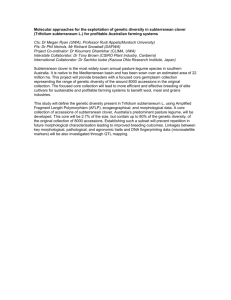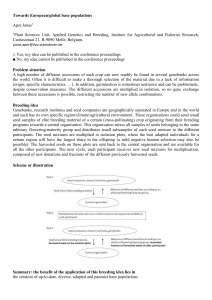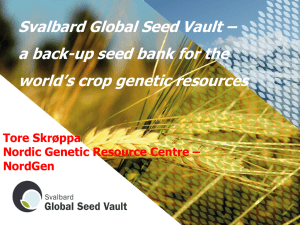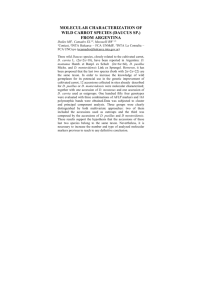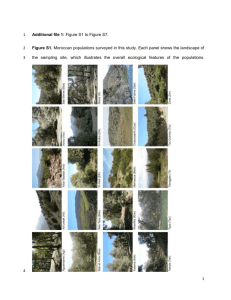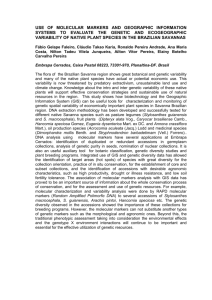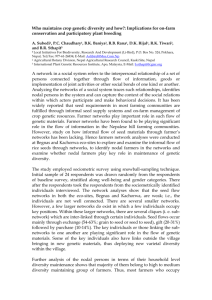nicklai ivanovich vavilov and his footprint on plant genetic resources
advertisement
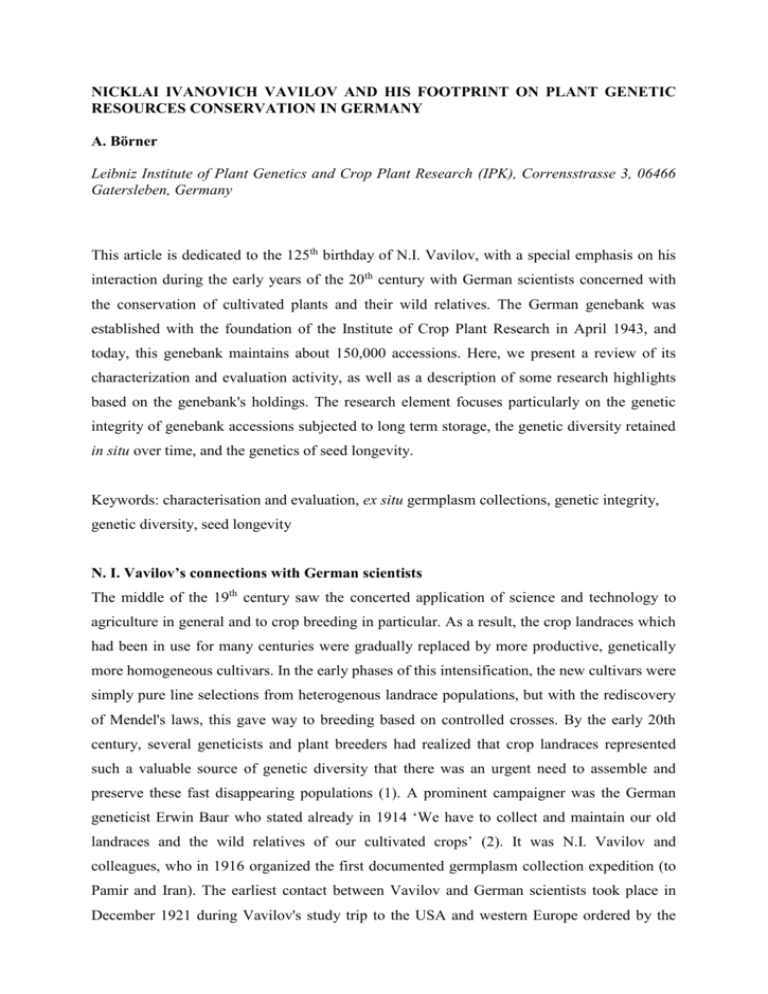
NICKLAI IVANOVICH VAVILOV AND HIS FOOTPRINT ON PLANT GENETIC RESOURCES CONSERVATION IN GERMANY A. Börner Leibniz Institute of Plant Genetics and Crop Plant Research (IPK), Corrensstrasse 3, 06466 Gatersleben, Germany This article is dedicated to the 125th birthday of N.I. Vavilov, with a special emphasis on his interaction during the early years of the 20th century with German scientists concerned with the conservation of cultivated plants and their wild relatives. The German genebank was established with the foundation of the Institute of Crop Plant Research in April 1943, and today, this genebank maintains about 150,000 accessions. Here, we present a review of its characterization and evaluation activity, as well as a description of some research highlights based on the genebank's holdings. The research element focuses particularly on the genetic integrity of genebank accessions subjected to long term storage, the genetic diversity retained in situ over time, and the genetics of seed longevity. Keywords: characterisation and evaluation, ex situ germplasm collections, genetic integrity, genetic diversity, seed longevity N. I. Vavilov’s connections with German scientists The middle of the 19th century saw the concerted application of science and technology to agriculture in general and to crop breeding in particular. As a result, the crop landraces which had been in use for many centuries were gradually replaced by more productive, genetically more homogeneous cultivars. In the early phases of this intensification, the new cultivars were simply pure line selections from heterogenous landrace populations, but with the rediscovery of Mendel's laws, this gave way to breeding based on controlled crosses. By the early 20th century, several geneticists and plant breeders had realized that crop landraces represented such a valuable source of genetic diversity that there was an urgent need to assemble and preserve these fast disappearing populations (1). A prominent campaigner was the German geneticist Erwin Baur who stated already in 1914 ‘We have to collect and maintain our old landraces and the wild relatives of our cultivated crops’ (2). It was N.I. Vavilov and colleagues, who in 1916 organized the first documented germplasm collection expedition (to Pamir and Iran). The earliest contact between Vavilov and German scientists took place in December 1921 during Vavilov's study trip to the USA and western Europe ordered by the Soviet Union government and specifically sanctioned by Lenin. Vavilov stayed for about two months in Germany, during which time he met with both Baur and the famous German plant breeder Theodor Roemer. After his return to the USSR, Vavilov described the current genetics and breeding research which he had observed in Germany, and sent copies of Baur’s most recent publications to Saratov. He also recommended that a report of the rye/wheat hybridization work done by G. Meister (a Saratov professor) should be forwarded to Baur (3). Vavilov returned to Germany in September 1927 to attend the 5th International Genetics Congress in Berlin, where he presented his theory of the geographical centres of origin of cultivated plants. Hans Stubbe, who in 1943 became the first director of the Institute of Crop Plant Research in Germany, attended the same conference and was impressed by Vavilov’s presentation. About a year and a half later, Stubbe met Vavilov again during the latter's visit to Baur, and took the opportunity to discuss his work on mutagenesis in Antirrhinum. At the 1st All Union Congress on Genetics, Plant, Seed and Animal Breeding, which took place in Leningrad in January 1929, the two German participants were E. Baur and R. Goldschmidt. In August of the same year, Stubbe was invited to Leningrad and Moscow to present his latest research results, and although Vavilov was away on a collection expedition at the time, he was aware of the visit. The final meeting between Vavilov and German scientists was in 1933 in Halle, where Vavilov gave his last oral presentation outside of the USSR (3, 4). A special symposium was held at IPK Gatersleben (at that time known as Central Institute of Genetics and Crop Plant Research) in December 1987 to celebrate the centenary of Vavilov's birth. One of the participants was Vavilov's son, Dr. Juri N. Vavilov, and an archival photograph records his meeting with Hans Stubbe at this symposium (Figure 1). The German genebank The idea of founding an Institute for Crop Plant Research in Germany with a mandate to conserve germplasm dates to the 1930s. Collection missions had been carried out by E. Baur and R. Schick in South America in 1930/31, by A. Scheibe in the Hindukush (1935/36), by C. Troll and R. Schottenloher in Ethiopia and Eritrea (1937/38) and by E. Schäfer in Tibet (1938/39). The outbreak of the Second World War delayed the foundation of the Institute until 1943. On April 1 of that year, Hans Stubbe was appointed by the President of the Kaiser Wilhelm Gesellschaft in Berlin as the first director of the Institute of Crop Plant Research. On the grounds of its more favourable climate, Fritz von Wettstein (the director of the Kaiser Wilhelm Institute of Biology) proposed to found the Institute in the Vienna region, and a 50ha site at Tuttenhof to the north of Vienna was identified. Frequent bombardment startin at June 26, 1944, however, forced the evacuation of part of the Institute late in the same year to the village of Stecklenberg on the eastern slopes of the Harz mountains. The remainder of the staff moved to Stecklenberg in April 1945, and by the end of that year, the Institute had been established on the Gatersleben site (5). From its inception, the guiding philosophy of the Gatersleben genebank was strongly influenced by the ideas and work of Vavilov and his co-workers. Its mandate was to establish and preserve a world-wide collection of crop cultivars and landraces, together with some representation of crop wild relatives. The collection was to be extended by collection missions and the exchange of material. Its role was to provide the basis for a comprehensive research programme dedicated to crop genetic diversity, and to make germplasm available for applied breeding research and practical plant breeding (Stubbe 1982). The number of accessions maintained by the collection grew from 3,500 in 1945 to over 150,000 by 2011 (Figure 2). During the 1970’s the size of the collection began to exceed what was manageable: until that time all the material was stored at room temperature, so regeneration was necessary every 2-3 years, necessitating the planting of 10,000 accessions per year. Further expansion only became possible with the construction of a low temperature storage facility in 1976. A particularly notable expansion in the collection occurred in 1992, when a number of separate collections held by former public sector breeding stations were merged into the IPK genebank, and then again in 2003 when the 45,000 accessions curated by the West German genebank at Braunschweig were transferred to Gatersleben. Growth since 2003 has only been slight (Figure 2). Today, the collection houses 3,212 species belonging to 776 genera (Table 1). The current inventory of the German ex situ genebank for agricultural and horticultural crops is given in Table 1 (6). The building accommodating the IPK genebank is named the ‘Vavilov Haus’. Here, the collection is maintained in large rooms held at -18°C. The active collection is kept in glass jars, covered with bags containing silica gel. Sub-samples of the basic collection are kept sealed in vacuum-packed aluminium envelopes at IPK, and as safety duplicate at the Svalbard Global Seed Vault in Norway. Although seeds stored at low temperatures can remain viable for decades, a regeneration programme is still necessary. So every year 8-10% of the holdings are recovered from storage and grown out, either in the field or under glass. Regeneration becomes necessary not just when average seed viability falls below a pre-set threshold, but also when the quantity of seed of an accession becomes depleted due to high user demand. New accessions are routinely multiplied before they enter the collection so that some characterization data can be obtained immediately. The way in which accessions are regenerated requires care to maintain their genetic integrity. Cross-pollinating species are multiplied in small glasshouses, or are grown in well-separated isolation plots in the field. The identity of every accession is monitored by the collection of voucher specimens, photographs and characterization data. Some 420,000 herbarium sheets and 154,000 voucher specimens of cereal spikes, seeds and fruits are available. Every year the genebank distributes 20,000-30,000 seed samples to a diverse group of users world-wide, representing research institutes, plant breeding companies, other genebanks, botanical gardens and sundry public organizations. The number of shipments made since 1953 totals over 840,000. Characterisation and evaluation of the genebank holdings The maintenance of the genebank collection goes hand in hand with an extensive programme of characterization and evaluation. The importance of this activity was recognized soon after the return of the pioneering collection missions. Systematic screening of the wheat collection for sources of disease resistance started as early as in 1933 at the Phytopathological Institute of the Faculty of Agriculture at the Martin Luther University Halle-Wittenberg, when an effort was made to perform seedling tests for reaction to infection with both stripe rust (Puccinia recondita) and leaf rust (P. striiformis). By 1939 these tests had been extended to the adult plant stage, and a screen for resistance against powdery mildew (Blumeria graminis) was added. When ear and stem diseases began to become more prominent after 1970, further disease screens were incorporated (notably for resistance against glume blotch (Septoria nodorum), eyespot (Pseudocercosporella herpotrichoides) and head blight (Fusarium culmorum)). The total number of seedling and adult plant stage tests performed over a period of 60 years numbers almost 150,000, applied to >10,000 Triticum spp. and ~500 Aegilops spp. accessions (7). The screens have identified numerous adult plant stage resistant accessions for each of the key diseases, and the proportion of accessions showing this sort of resistance has consistently been higher than that showing resistance at the seedling stage. More recently, the evaluation activity at IPK has been extended to crops of medicinal interest such as the opium poppy (Papaver somniferum) and herbs such as parsley (Petroselinum crispum). The morphology of a set of 300 opium poppy accessions of diverse geographical origin has been documented by growing the material in the field at Gatersleben over three different years, while at the same time a genotypic description was obtained through DNA profiling with amplified fragment length polymorphisms (AFLP). Finally, variation for the content of the five major opium alkaloids (morphine, codeine, thebaine, papaverine and noscapine) was measured using high performance liquid chromatography (HPLC) (Figure 3), an exercise which confirmed how variable alkaloid content is in the species (8). The 220 accessions of the German parsley germplasm collection were grown out at two contrasting sites for the purpose of morphological characterization. Two different leaf types were represented (curled and smooth) and 25 of the accessions were root parsleys. A few of the accessions were heterogeneous. When molecular markers were applied in an attempt to clarify the genetic architecture of the collection, the observation was that the root parsleys clustered with some of the smooth leaf parsleys, while the remaining smooth parsleys formed a separate cluster along with the smooth types. An analysis of the content of essential oil and volatile compounds suggested that the relative contents of myrcene and β-phellandrene provided a diagnostic for discriminating between root and leaf parsley. The variation for volatile compound content defined two groups which were congruent with those generated by the marker genotyping (9). External partners have contributed to screens of the accessions in the genera Aegilops, Agrostemma, Allium, Amaranthus, Anethum, Apium, Avena, Barabarea, Beta, Brassica, Camelina, Carum, Coriandrum, Cucumis, Eruca, Foeniculum, Helianthus, Hordeum, Hypericum, Lactuca, Lathyrus, Lepidium, Linum, Lupinus, Lycopersicon, Matthiola, Ocimum, Papaver, Petroselinum, Phaseolus, Pisum, Secale, Spinacea, Sysimbrium, Raphanus, Triticum, Triticale, Vicia and Zea. All of these characterization data are freely available via the internet (http://www.ipk-gatersleben.de). Research activity at the genebank Genetic integrity At IPK molecular markers (microsatellites) were used to compare seed harvested from the most recent regeneration and a herbarium voucher specimen collected from the initial multiplication. This procedure has been applied to wheat accessions which have been regenerated as many as 24 times over a 50 year period. The fact that this exercise has as yet failed to detect significant evidence of either out-crossing or incorrect handling underlines the care and efficiency with which genetic integrity has been maintained over a long period (10). Endosperm storage protein profiling of the same material carried out by the N. I. Vavilov AllRussian Research Institute of Plant Industry (VIR) in St. Petersburg (11) has validated the conclusions drawn from the microsatellite genotyping. For the cross-pollinator rye, the situation is however rather different. Accessions which had been regenerated up to 13 times have suffered marked shifts in allele frequencies. Whereas at some loci a decreased frequency (or even complete loss) of alleles was observed, at others new alleles were detected, presumably reflecting incoming pollen from unrelated rye populations (12). The extent of the change could be related to the number of multiplication cycles (Figure 4). As a consequence, the regeneration management scheme for crosspollinating species in ex situ collections needs to be reviewed, specifically addressing the questions of minimum population size and spacing between adjacent regeneration plots. Genetic diversity Re-sampling of the germplasm still present in areas targeted previously by early collectors has allowed for some quantification to be attempted of the severity of the genetic erosion which has occurred over the passage of 40-50 years. One such case study in wheat has been described by (13). The genetic diversity present in the original and the subsequent collections was quantified on the basis of the mean number of alleles represented at a selection of microsatellite loci distributed randomly across the genome. The consistent picture which emerged was that the amount of genetic diversity was remarkably stable over time in each of the collection sites (Austrian Alps, Nepal, India and Albania). However, there was good evidence for some qualitative changes in diversity, in that about one third of the alleles uncovered proved to be unique to a single collection period (Figure 5). These findings demonstrate that an allele flow (qualitative change) took place during the transition from traditional agriculture to a more intensive production system, whereas the quantitative level of genetic diversity was rather stable. A comparable study in barley compared sites in Austria, Albania and India (14). There was a lack of variation in the total number of alleles per locus among either the Austrian or the Indian material, but a minor reduction was noted for the Albanian entries. As for wheat, the frequency of collection mission-specific alleles suggested a significant level of allele flow over time. The overall conclusion has been that ex situ collections necessarily can only preserve a snapshot of genetic diversity, which in nature responds in a dynamic fashion to changes in the agricultural environment. Seed longevity As the majority of genebank accessions are stored in the form of seed, seed longevity is a particularly important issue for germplasm curators. The IPK has been exploring this trait for a range of the species represented in the genebank. A high level of interspecific variation for seed longevity could be identified when seed was stored at ~20°C and 50% relative humidity (15). Of the 18 species investigated, the seeds of pea (Pisum sativum) retained their viability for the longest period (29 years) and those of chive (Allium schoenoprasum) for the shortest (five years). Intraspecific variation was apparent for seed stored between 26 and 33 years at 0°C (16). Germination was highest within five years of storage; however, varieties diverged with respect to their seed viability when the storage period was prolonged to 20 years. Examples are shown as Figure 6. In wheat, the rate of germination varied between 0 and 87% after 34 years of storage, while in barley the range was 43-95% after 35 years. Given that the conditions associated with the regeneration and post-harvest treatment were identical for a given batch of accessions, the clear conclusion was that these differences in viability must be genetically based. As a result, a programme was initiated at IPK to genetically analyse seed longevity, using accelerated ageing tests based on International Seed Testing Association (ISTA) protocols (17). QTL and association mapping has been performed for barley, oilseed rape and wheat (18, 19, 20), and an illustrative example (oilseed rape) is presented as Figure 7. Literature 1. Lehmann Chr.O. Genetic Resources, Die Kulturpflanze, 1988, 36: 71-83. 2. Baur E. Die Bedeutung der primitiven Kulturrassen und der wilden Verwandten unserer Kulturpflanzen für die Pflanzenzüchtung. Jb. Deut. Landw.-Ges., 1914, 29: 104-109. 3. Esakov V.D. On the scientific relations of N.I. Vavilov to German geneticists and breeders. Die Kulturpflanze, 1988, 36: 61-69. 4. Käding E. Engagement und Verantwortung – Hans Stubbe, Genetiker und Züchtungsforscher. Zentrum für Agrarlandschafts- und Landnutzungsforschung (ZALF) e.V., 2001, 36, 272 pp. 5. Stubbe H. Geschichte des Instituts für Kulturpflanzenforschung Gatersleben der Deutschen Akademie der Wissenschaften zu Berlin (1943-1968). Studien zur Geschichte der Akademie der Wissenschaften der DDR. 1982, 10, 428 pp. 6. Anonymous. Scientific report 2010/2011, Leibniz-Institut für Pflanzengenetik und Kulturpflanzenforschung (IPK), 284 pp. 7. Börner A., Freytag U., Sperling U. Analysis of wheat disease resistance data originating from screenings of Gatersleben genebank accessions during 1933 and 1992. Genetic Resources and Crop Evolution, 2006, 53: 453-465. 8. Dittbrenner A., Lohwasser U., Mock H.-P., Börner A. Molecular and phytochemical studies of Papaver somniferum in the context of intraspecific classification. Proc. 5th International Symposium on the Taxonomy of Cultivated Plants, 15-19 October 2007, Wageningen, The Netherlands, Acta Horticulturae, 2008, 799: 81-88. 9. Lohwasser U., Struckmeyer T., Budahn H., Krüger H., Ulrich D., Declercq M., Börner A., Marthe F.: The German parsley germplams collection – interaction of morphological, molecular and phytochemical characters. Acta Horticulturae, 2010, 860: 235-240. 10. Börner A., Chebotar S., Korzun V. Molecular characterization of the genetic integrity of wheat (Triticum aestivum L.) germplasm after long-term maintenance. Theor. Appl. Genet., 2000, 100: 494-497. 11. Konarev A., Gubareva N., Kornuchin D., Börner A.: Gliadin electrophoretic analysis of the genetic integrity of wheat (Triticum aestivum L.) accessions after frequent seed reproductions. Genetic Resources and Crop Evolution, 2005, 52: 519-523. 12. Chebotar S., Röder M.S., Korzun V., Saal B., Weber W.E., Börner A. Molecular studies on genetic integrity of open pollinating species rye (Secale cereale L.) after long term genebank maintenance. Theor. Appl. Genet., 2003, 107: 1469-1476. 13. Khlestkina E.K., Huang X.Q., Quenum F.J.-B., Chebotar S., Röder M.S., Börner A. Genetic diversity in cultivated plants – loss or stability? Theor. Appl. Genet., 2004, 108:1466-1472 14. Khlestkina E.K., Varshney R.K., Röder M.S., Graner A., Börner A. A comparative assessment of genetic diversity in cultivated barley collected in different decades of the last century in Austria, Albania and India by using genomic and genic SSR markers. Plant Genet. Res., 2006, 4: 125-133 15. Nagel M., Börner A. The longevity of crop seeds stored under ambient conditions. Seed Sci. Res., 2010, 2:1-20. 16. Nagel M., Rehman-Arif M.A., Rosenhauer M. Börner A. Longevity of seeds intraspecific differences in the Gatersleben genebank collections. Tagungsband 60. Tagung der Vereinigung der Pflanzenzüchter und Saatgutkaufleute Österreichs, Gumpenstein, Österreich, 24-26 November 2009, 2010, 179-181. 17. ISTA International rules for seed testing. International Seed Testing Association, Bassersdorf, 2008. 18. Nagel M., Vogel H., Landjeva S., Buck-Sorlin G., Lohwasser U., Scholz U., Börner A. Seed conservation in ex situ genebanks – genetic studies on longevity in barley. Euphytica, 2009, 170 5-14. 19. Nagel M., Rosenhauer M., Willner E., Snowdon R.J., Friedt W., Börner A. Seed longevity in oilseed rape (Brassica napus L.) – genetic variation and QTL mapping. Plant Genet. Res.: Characterisation and Utilisation, 2011, 9: 260-263. 20. Rehman Arif M.A., Nagel M., Neumann K., Kobiljski B., Lohwasser U. Börner A. Genetic studies of seed longevity in hexaploid wheat using segregation and association mapping approaches. Euphytica, 2012, online, DOI 10.1007/s10681-011-0471-5. Figure 1: Juri Vavilov (left) and Hans Stubbe (right) during the N.I. Vavilov Symposium held at Gatersleben from December 8-10, 1987. Number of accessions 160000 140000 120000 100000 80000 60000 40000 20000 19 46 19 50 19 54 19 58 19 62 19 66 19 70 19 74 19 78 19 82 19 86 19 90 19 94 19 98 20 02 20 06 20 10 0 Year Figure 2: Growth of the Gatersleben genebank collection in the period 1946-2011. Figure 3: Variation in the content of the five major opium alkaloids among 50 accessions of Papaver somniferum. A B Figure 4: Variation in allele frequency at the microsatellite marker RMS18 in samples of cereal rye accessions R784 (A; 2 cycles) and R 78 (B; 12 cycles). The earliest regeneration cycle is marked in yellow, and the most recent in red. Figure 5: Mean number of alleles per locus present in bread wheat accessions collected during expeditions to Austria (1922/32 and 1982), Albania (1941 and 1994), India (1937 and 1976) and Nepal (1937 and 1971). Unique alleles are shown in yellow (early expedition) or red (recent expedition) columns, while common alleles are indicated by a colour mix. Figure 6: Mean germination of wheat (Triticum L.), barley (Hodeum L.), flax (Linum L.) and rye (Secale L.) accessions, demonstrating intraspecific variation for seed longevity after long term low temperature storage. Figure 7: QTL for seed longevity following artificial ageing mapped to Brassica napus chromosomes N06 and N07. Table 1: Overview of the Gatersleben collection and the extent of its distributional activity. Assortments Accessions Distribution in 2011 Cereals and Grasses wheat barley oat rye Triticale Aegilops millets maize grasses 65448 28111 23245 4835 2411 1581 1531 845 1550 1339 7036 2932 1031 119 273 26 1549 474 245 387 Legumes Phaseolus field beans soybeans other beans pea chickpea vetchling vetches lupins lentils clover species others 28066 9146 3283 1514 624 5295 531 524 1878 2769 475 1739 288 3163 776 344 70 312 119 799 64 383 75 101 81 39 Cucurbitaceae pumpkins melons cucumbers others 2671 1081 726 709 155 1311 597 196 459 59 18794 3544 1532 112 2320 750 500 690 3319 2184 1130 214 252 957 1290 10838 2969 407 70 100 89 2804 164 470 262 399 91 508 1237 1268 Vegetables tomatoes pepper eggplants Beta Raphanus carrots chicory Allium Brassica lettuce spinach celery Quinoa others Table 1: Continued Oil, Fibre, Dye Plants flax sunflower dye plants fibre plants oil plants others 5526 2324 691 481 187 557 1286 1844 92 256 291 185 488 532 Medicinal, Spice Plants poppy tobacco others 8344 1149 590 6605 5273 239 145 4889 Mutants tomatoes soybean Antirrhinum 1771 744 567 460 108 79 9 20 Potatoes 6124 1965 14258 2472 10441 1345 151002 2340 1847 446 47 33878 Oil and Forage Crops rapeseed and feeding kale grasses red clover and alfalfa Total
